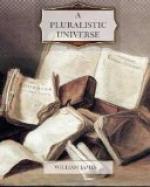But in due course of time the intellect awoke, with its passion for generalizing, simplifying, and subordinating, and then began those divergences of conception which all later experience seems rather to have deepened than to have effaced, because objective nature has contributed to both sides impartially, and has let the thinkers emphasize different parts of her, and pile up opposite imaginary supplements.
Perhaps the most interesting opposition is that which results from the clash between what I lately called the sympathetic and the cynical temper. Materialistic and spiritualistic philosophies are the rival types that result: the former defining the world so as to leave man’s soul upon it as a soil of outside passenger or alien, while the latter insists that the intimate and human must surround and underlie the brutal. This latter is the spiritual way of thinking.
Now there are two very distinct types or stages in spiritualistic philosophy, and my next purpose in this lecture is to make their contrast evident. Both types attain the sought-for intimacy of view, but the one attains it somewhat less successfully than the other.
The generic term spiritualism, which I began by using merely as the opposite of materialism, thus subdivides into two species, the more intimate one of which is monistic and the less intimate dualistic. The dualistic species is the theism that reached its elaboration in the scholastic philosophy, while the monistic species is the pantheism spoken of sometimes simply as idealism, and sometimes as ‘post-kantian’ or ‘absolute’ idealism. Dualistic theism is professed as firmly as ever at all catholic seats of learning, whereas it has of late years tended to disappear at our british and american universities, and to be replaced by a monistic pantheism more or less open or disguised. I have an impression that ever since T.H. Green’s time absolute idealism has been decidedly in the ascendent at Oxford. It is in the ascendent at my own university of Harvard.




